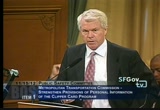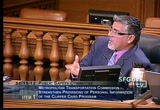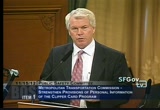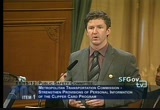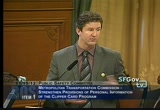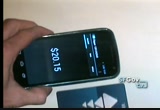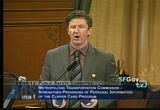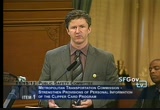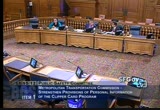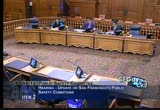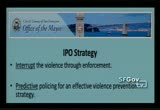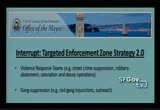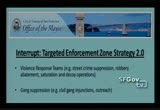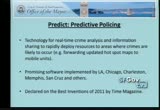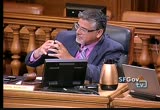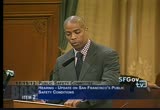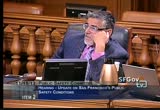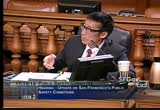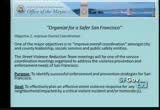tv [untitled] December 1, 2012 5:30pm-6:00pm PST
5:30 pm
subject is the commission is expected to get some recommendations with us with respect to how long we keep information on closed accounts. it was set many years ago probably on business and financial reasons, not really thinking about the privacy part, so we're certainly going to bring that back to the commission as a direct result of your interest in this subject and you have a lot of other good suggestions here as well. i can answer specific questions about why clipper works the way it does with respect to the information we keep on the card, the transactions, which mostly have to do with the fact we want to give people the discounts they are due as a result of different transit offers and transfers and so on. i just want to thank your staff for working with us on this resolution. >> thank you, i appreciate your work with jeremy pollock in my office. i guess i have one big question and that is like 3 clipper cards myself. i purchase them with a commuter
5:31 pm
benefit check at walgreen's, i don't know if anyone really knows they actually belong to me. i also have a commuter benefit visa card that i am able to purchase clipper cards at vendor sites at bart stations. i'm not sure there's actually, besides linking that clipper card to my visa card whether there's actual understanding that i am the owner of that clipper card. so how many people actually is the program able to identify a particular card with a particular person? >> so this is a clipper card here. the information on this card is essentially the serial number of the card and it has your last 10 transactions on it so if you used it to ride bart or used it to ride muni, the last 10 are on there. in order to calculate your discounts if you need them, other than that, there's no information on the card other
5:32 pm
than, again, the loading in the pass -- so if you put $10 on it or put a fare on it, it has that. but your personal information is separate and is at a customer service center that is far away and not linked to your card. no one can get anything from your card even if these devices which are being introduced scan it. your information resides in a customer center station. so the customer service which is privately contracted out, is really the only place where a connection is made to you as a person and almost -- only as a result of your request. >> okay. thank you. if there are no other comments or questions we will go on to public comment. any member of the public who would like to comment, please
5:33 pm
come forward. >> thank you, members of the board, my name is chris connelly. part of our mission is to make sure that as new technology comes along that people don't have to choose between using the new technology and keeping their privacy. we are pleased to hear that mtc is taking action that clipper action, although not as precise as information from a cell phone, can reveal a lot about a individual. it can reveal if you got on or off bart near a hospital, near a clinic, all sorts of things that may imply things about your personal life and particularly over a long period of time there is an extensive
5:34 pm
amount of information collected about a person. are they going to church on a regular basis. are they going to baseball games when they are supposed to be at work? i think it is important to recognize that these records should be respected, should be treated as private information and as the commission said, should be looked at and retained only as long as necessary for operational purposes, not because it's cheap to retain data but because you need them for fraud. i'd like to demonstrate to the committee, this is an application for an android app >> what is it called again?
5:35 pm
fare bot it requires a new android phone that has an (inaudible) all you need to do with the app, attach it to a card, the balance available on the card, recent trips, i believe it's actually 15 recent transactions rather than 10 if you count these up, and it is no time limit so it may be 15 in the last week or 15 in the last number of months or even years potentially, when the card has been refilled and it also records information about the identity, the serial number about the card and a few other technical details. this can reveal a little bit of information about a person in a
5:36 pm
single read, but notably it can be used repeatedly and because it reads the serial number, you can record the same person, see if it's the same card. you can use it on a smart card to track your partner or your child or your parent or anyone's card you have access to on a regular basis, you can obtain information about their comings and goings. technologically it's possible to build a better reader than on a smart phone. i'm not sure of the distance but it would not require contact with the cards under a stronger radio technology to receive signals and receive signals from the card. this is something i hope the information will address, the fact it's not encrypted in any way so anyone with a phone can read not only their own clipper card but anyone's clipper card and finding ways to make sure that information is secure. finally i'd like to endorse what you have added to this, which is the transparency provision here, which is to require the mtc to report every year on how many requests it
5:37 pm
receives for information and how it handles those requests. as we know there is a great deal of interest from many parties, law enforcement, civil litigants and others about location information and other information about individuals. we need to have transparency about how often this information is being shared in order to have an informed dialogue with you, with the commission, with the public and our legislators about how to handle this information, and information about whether those requests are complied with. thank you very much. >> thank you, i think that's the strongest part of the resolution. supervisor mar. >> i want to thank the aclu for raising concerns about the privacy concerns. i am surprised about how much information from an app you can get. supervisor avalos and i
5:38 pm
were chatting a little bit, my 12-year-old using her clipper card quite a bit. i am curious whether she goes where she says she is but i understand the privacy concerns especially within the mta to be more transparent so i am really appreciative of the legislation and i'd like to ask if i could be added as a co-sponsor as well. >> great. it's important to say that the resolution references that it's really bart and the material that bart's able to put on their clipper card that actually does the tracking, but in the end within the mta you really can track where someone has been within the mta system of san francisco so that might not help you with your daughter. okay, we will close public comment and we actually have a member of the whole, we can take that, colleagues, i don't have a copy, eric, do you have a copy of that? so we can take
5:39 pm
that, colleagues, without objection, member of the whole? and we can send the item forward with recommendation? okay, good. let's call our next item, please. >> item no. 2, hearing to receive a briefing on san francisco's public safety conditions from the san francisco police department and mayor's office of criminal justice. >> great, thank you, madam clerk. i called this item, we haven't had an update in a number of months from our department, public safety department, about how we are doing as a city in terms of responding to crime in our city. so we have jason elliot who is here to start off the presentation. >> thank you, mr. chair, jason elliot from the mayor's office. i will be very brief. thank you for calling this hearing and continuing to pay attention to this issue, it's a
5:40 pm
topic of constant conversation in meetings in the mayor's office. what we're going to present to you today is a condensed version in the interest of time, an overview of the mayor's new ipo interrupt, predict and organize strategy to fight crime. this was a strategy that was developed and implemented in july, it's now november so we have begun to see fruits of that labor. so we will provide a brief update there and then commander murphy from sfpd will respond to the other part of the hearing request, which is for actual crime trends and hard data. so without further ado and now that i'm thoroughly terrified of what my clipper card information is contained on there, let me turn it over to the mayor's director of public safety, paul anderson. >> mr. anderson, welcome. >> good to see you again. with that introduction we have a little slide show here with
5:41 pm
the information. basically here is our strategy and all of these things are kind of interrelated so they all fold into each other, but interrupt, predict and organize are basically how we have structured what this new approach is. that's kind of the innovative aspect of it. basically it's broken down like this. the interrupt like this is interrupting the violence through enforcement. the predictive component is predictive policing for more effective prevention strategy and the organizing, social service agencies, enforcement agencies, faith based organizations, business to work collaborative kind of the thing you see in the community and on the streets. so it's kind of a new partnership that we've built and that's that innovative component that we put into the strategy. i'm going to just talk a little bit about both myself and deanna, who is going to get
5:42 pm
up in a moment and the police department is going to get up in a moment. i focused really primarily on the i and the p, which is interrupt and predict, so i want to give an overview of what that is and how it works so you have a better understanding of what we're doing. so the interrupt part, which is also an introduction of the new zone strategy within the police department, includes the following: does this roll up? you guys have it in front of you. the violence response teams, the vrt's, it includes gay suppression efforts, violence cease fires, all of our gun abatement programs collectively and our yuelgt and family programs which also dovetails into the organizing component. a lot of these things may look familiar to you because some of
5:43 pm
them are existing resources that were already in place. the innovative component or the innovative approach is figuring out what the best practices were in making sure they were all inder linked in new ways of both accountability and starting from the top from a senior level with the chiefs and the heads making sure there's information to share. i think to put a framework on it so it's this context for all of you, some of the new things we're dealing with are the prcf results that have come out as a result of realignment because that's added a whole another layer in terms of what public safety looks like and how the departments are responding. >> could you spell out or actually --. >> sure, that's the post release community supervision. i just wrote it down. i just use it all the time and i just
5:44 pm
wrote down anticipating that question. >> that's related to? >> that's related to the movement within government to release people from the state prison system back into local authority. so what that has caused throughout the entire state is that there is a new classification of individuals that are being released from custody to specific jurisdictions and in san francisco, you know, we've really taken the lead in terms of being prepared for that community coming back here. and it's folded into the ipo and part of the reason why we have an ipo is to address that concern because it is something new that all counties have to deal with in different ways. so i just wanted to put it in context how we got here and what it means and how it works kind of from the top, all of this is under ipo but this is how we got here and what we're dealing with. so that's the interrupting component. from a predictive component,
5:45 pm
or the p in the ipo, really what we do here, and the police are going to speak to this and give you a little detail because i think you guys want more detail in how it works, but generally the approach with predicting is using the technology we have with realtime crime analysis. i think everyone here is almost somewhat familiar with comstat and what we've done in the past and how information was kleted collected in the past. but now what we're doing is using the information we collect from comstat and realtime when there's a crisis to be addressed or problems that come up we can deploy resources based on the research that we've collected. the other thing that we're looking at right now are software in terms of best practices throughout the country, software that actually does some of the police predicting as well. it's listed there, some of the
5:46 pm
cities that we've seen those in place that we're contemplating adding to the police department here in san francisco. but before we even get there, we've already deployed, murphy is going to speak to this when i sit down, but he's already working on doing the realtime deployment and doing the analysis of the predictive policing itself. >> what would i be interested in hearing -- it seems you have ipo, interrupt, predict, organize. >> uh-huh. >> it seems like those are things that typically bee do as a city already, so what is actually new and how can you explain a new modality in terms of policing that is really come into effect with ipo? >> while some of these things may have existed in the past what we've done is analyze what
5:47 pm
is working best. one of the big enhancements or innovations we have introduced about some of the old tools is how we share those resources and communicate back and forth with each other. even though adult probation dealt with probationers and even though san francisco police department was dealing with people on the streets, having them at the same table at regular meetings discussing specific issues of concern as they come up like the, as i was explaining before, with the realignment stuff, these are fairly new things that have to be discussed and have to be prepared and have to be integrated in the communications so it's not just the law enforcement agencies working in silos addressing their own jurisdictions. there aren't really real jurisdictions in law enforcement. they have to be sharing information collectively and that's from the top to the bottom. just specifically talking about the ipo, i think what's new and i think is more helpful
5:48 pm
than not is the focus with organizing and the community component so it's not just a community dealing and reacting to public safety, it's the community sharing information with and through law enforcement so that they are part of the discussion and really partners and how the city approaches what public safety is. am i answering the question? >> yes, and if you could explain how you have been able to implement an ipo strategy within, say, visitacion valley, has has this resulted in real communication and collaboration, what are the examples of your organization and the department and how they work together. >> i don't want to steal deanna's thunder, the stuff where you see literally on the streets where you are talking about specific streets and specific districts. but from the i and the o perspective,
5:49 pm
how that works, that information as it goes up, what's happening is we have regular meetings from these agencies that are dealing with that information when it comes in from the streets. so it's not just we may have had an incident that happened last week, for example, it's what happens as a result -- let's say there is a shooting in whatever neighborhood. as a result of that shooting, the situation doesn't end because someone was arrested. the situation doesn't end right there. individuals are still dealing with that trauma. the neighborhood is still affected. you need to figure out what the root causes are from that shooting so one of the things that's happening now is that neighborhoods are meeting and communities are coming together to discuss those incidents. then they are also sharing that information with law enforcement so it goes back up into the ranks so they can accommodate more quickly how to respond, not just to make sure that someone got shot, now they are being held accountable and that person may go to jail or
5:50 pm
be in prison, but we are integrating law enforcement to make sure we don't have that same kind of shooting in the future. or if this is something that law enforcement can insert itself in to make sure we don't have related shootings occurring as a result of that first shooting. is that making sense? some of these things were happening before, but they weren't happening at the level that they are happening now where we're having such shared communication that it's going back and forth from top to bottom so the meetings that are taking place in the community, that information is being shared all the way up to the top in the law enforcement agencies and they are adapting and developing policies to address those situations. if you have specific stuff, i know when we get to the organizing part we're going to flesh it out as to what that looks like on the street on a daily basis and what it looks like in specific neighborhoods. >> so, yeah, this is really helpful to get the bigger overview and you just gave an example if there's some
5:51 pm
activity in a neighborhood, crime activity, that you can then kind of focus more on preventative strategies to prevent it in the future. there were i think 4 armed robberies in the richmond district in august. i know we were working closely with the police captain in our district, but knowing more how there's a city-wide approach to creating a merchant watch area or some concentrated crime prevention strategy, that would be really helpful for me to know. >> with that example specifically, so there were already agencies that existed like sf safe that would organize merchants and they would come in. but having sf safe be activated by the specific incidents that have happened, those are some of the new approaches and some are those of the innovative practices we have now so it's more than just a happenstance occurrence, a community-based organization that has a role to play will play it. we're all
5:52 pm
talking and communicating and sharing information now so when there is an incident it's not just, okay, there are that robbery and there were 4 separate robberies because there weren't 4 separate robberies, there is that link even if that link is just that's happening in the same place. what that says to law enforcement is that this community can be taking steps to make sure as we have those 4, there's not going to be 5. >> i'm pleased even though 3 suspects were apprehended, it doesn't stop there, there's on-going community-based efforts. i'm glad to hear the big overview how it works in our neighborhood. >> that's exactly the point. it's the umbrella. ipo is the umbrella and all these things fall under the umbrella but it's not just at the bottom, it goes all the way to the top and there are scheduled meetings to make sure the chiefs and the department heads of all those agencies are getting
5:53 pm
information and feedback what's happening in the specific neighborhoods and then it folds into the predictive policing to make sure the resources are there and the information is shared. again, like i said, i think it's really important that we stress the information flows back and forth from the top to the bottom so the information of what law enforcement is doing is being shared on the streets so that people can share resources and accommodate how they can partner with law enforcement and things are happening with the community, not to the community. with that, let me introduce the organization because i think that folds into what's happening in the district so she can answer more questions. deanna >> i would say that one of the more forward seconds of moving forward --. >> i'm sorry, please identify yourself. >> i'm sorry, deanna navar
5:54 pm
leche, thank you for having us here. i'll just pick up where paul left off. in terms of the organized section, it really emphasizes the importance of making sure there's a bridge between social service agencies and enforcement agencies, that there's an on-going dialogue as paul mentioned in trying to create a strategy that is effective not only in targeting individuals that are high at risk and in custody but targeting the faith based community, using our strength as a community in general to mobilize and organize communities to promote stop the violence. i would say this is one of the newer approaches throughout my time in the last 10 years that i've been doing violence prevention i've never seen a component that really emphasizes the organizing piece that really pushes to get out to the community and functions at the ground level. a little bit more about that, in terms of organize, again, it
5:55 pm
relates to a strategy, it emphasized implementing a coordinated social service strategy. we also are looking into trying to create wrap around programs that address intervention needs, work force needs and in general educational needs which are very much prior indicators of why many individuals end up actually engaging in violence. so we want to get to those factors, right, that really inhibit someone from progressing in life in general and at the same time we want to be able to build successful wrap around programs. those are major pieces of the o section. another huge area that is very new in some of our (inaudible) city and county is an education and mobilization section, an objective that really relates to trying to really rely on our strengths in the community residents whether it be faith based groups,
5:56 pm
individuals who are just passionate about stopping violence, really working with them to create community gatherings and to create in general a plan so they can go ahead as a community and give us input at the mayor's office what needs to be done to really stop the violence in general. so that's the organized section as a whole. the ipo, you know, you will see it divided into the seconds that paul discussed which relate to interrupt, predict and organize. as i mentioned earlier, there are specific objectives that relate to each section that really emphasize just trying to bring the umbrella together to create a safer san francisco. so this is just a draft template because we're still creating a lot of, we're having an opportunity where we're allowing input to come in for the next couple months to really solidify this chart. we're working closely with city agencies trying to reflect do we need to shift anything, do we need more input, we're going out to the community, working closely with our faith-based
5:57 pm
constituents to make sure we capture all the needs in each area. one of the areas that have been activated and supervisor avalos, you were one of the first supervisors that engaged in this setting in the street response team is exactly that, the street violence response team. it's a new approach and it really tries to emphasize trying to coordinate and overall strategy whenever there's a homicide or a critical assault that's impacting a community. as paul discussed, this is an opportunity where the purpose is to really focus on an actual critical incident that has happened and it has really impacted san francisco as a whole. homicides impact all families, children and families throughout the city and county so the mayor's office thought it was important to begin organizing a critical response team that would basically create a table of captains from a station, the cbo's that are doing the work on the ground
5:58 pm
level, the sfcrn that is doing the street outreach and they are involved depending on the incident, dph's critical response team, crisis response services, and the victim witness program and sfusd if it relates to individuals in the sfusd structure. how do we activate this? the way we activate this, sfpd provides the information it our unit in 24 hours whenever there's a homicide or critical assault. then following that, what i do is then i assess and determine whether a meeting needs to take place in 2 days or whether we can go ahead and have the discussion in our weekly session. so for homicides we will be responding in two days just because of the critical matter and we want to make sure that family and children and youths and anyone that's impacted
5:59 pm
receives services in a coordinated fashion. for critical assaults we will be having a weekly meeting from 2.30 to 3.30 every tuesday to review what is happening, how is it impacting individuals and how is it impacts community. i have a team that's going to be working with us to try to actually make sure that there's a response, that there's a traction and a tracking mechanism where we make sure everyone that has committed resources that they follow-up immediately and that the families or anyone that's impacted really receives a whole full bredth of service plan. this is a new and innovative approach. we've never done it in this fashion. in terms of confidential pieces --. >> i might stop you for a second. are you personally in direct relationship with any of the families or you are aware ofyo
150 Views
IN COLLECTIONS
SFGTV: San Francisco Government Television Television Archive
Television Archive  Television Archive News Search Service
Television Archive News Search Service 
Uploaded by TV Archive on

 Live Music Archive
Live Music Archive Librivox Free Audio
Librivox Free Audio Metropolitan Museum
Metropolitan Museum Cleveland Museum of Art
Cleveland Museum of Art Internet Arcade
Internet Arcade Console Living Room
Console Living Room Books to Borrow
Books to Borrow Open Library
Open Library TV News
TV News Understanding 9/11
Understanding 9/11